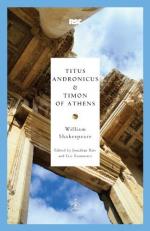|
This section contains 7,921 words (approx. 27 pages at 300 words per page) |

|
SOURCE: “The Paradox of Timon's Self-Cursing,” in Shakespeare Quarterly, Vol. 35, No. 3, Autumn, 1984, pp. 290-304.
In the essay below, Scott considers liar paradox constructions in Timon's curses on mankind and himself.
In his essay “how to do things with Austin and Searle”—reprinted with a qualifying comment in Is There a Text in This Class?—Stanley Fish employs speech-act theory to describe the behavior of Coriolanus. Seeking the people's votes for the consulship, Coriolanus refuses to conform to accepted codes of speech and therefore of social conduct, and retorts to his banishers, “I banish you!”1 Fish says that Coriolanus both evokes expectations of conventional behavior and frustrates them here, undoing what purport to be his own verbal gestures. To Fish, Coriolanus is a special case among Shakespeare's plays. He thinks, therefore, that the opportunities for speech-act analysis of Shakespeare are limited. Coriolanus is “about speech acts, the rules of...
|
This section contains 7,921 words (approx. 27 pages at 300 words per page) |

|


